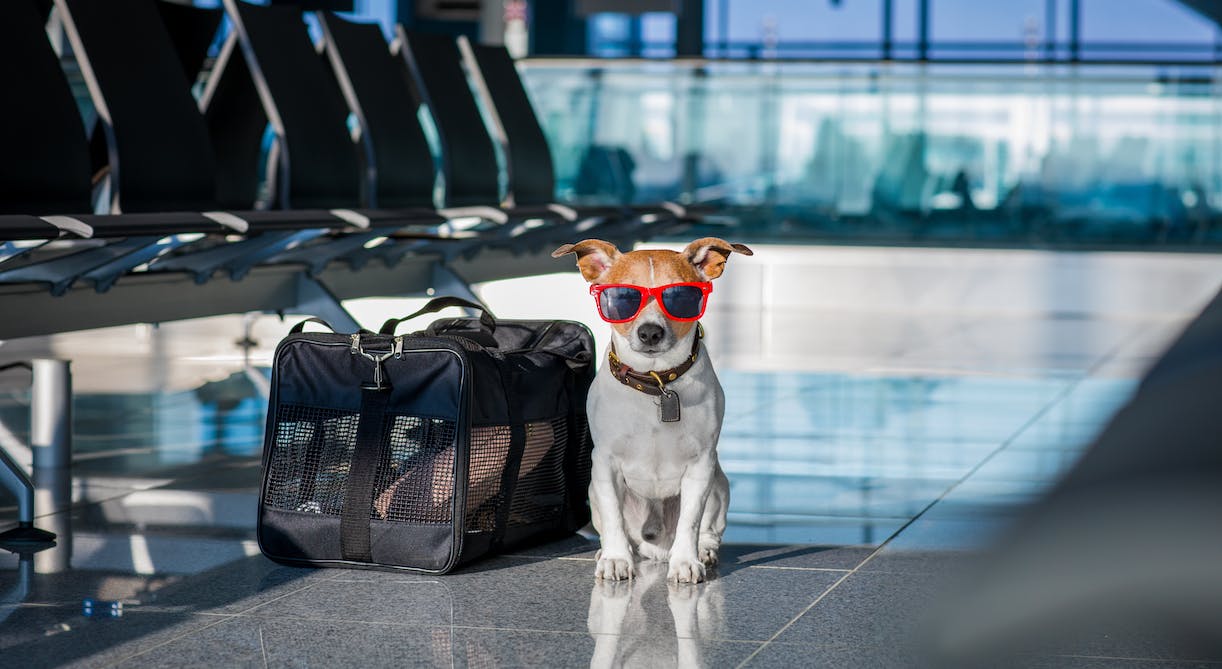You can't wait to roam along majestic California beaches with your 4-legged buddy at your side? Before you write the captions for your Instagram photos, be sure to check the ins and outs of travelling by air with your pet. Did you know, for instance, that some breeds of dog, due to common respiratory problems, aren't allowed onboard several airlines? It's a good idea to plan your trip several months before your departure to give yourself the time to find out about airline policies. You should also find out about your destination's regulations, which vary from country to country. With a little preparation, you and your companion animal will be set for a memorable, hassle-free vacation!
Cabin or hold
Most veterinarians agree that it's preferable for an animal to travel in the main cabin—a less stressful option for an animal than travelling in the hold due to the sustained contact with their owner. And temperatures there tend to be more comfortable than in the baggage hold. However not all animals are allowed in the main cabin, which is generally restricted to animals weighing less than 9 kg. Pets must also be small enough to stand, turn around and lie down comfortably in their carrier. Carrier size and related fees vary from company to company.
Your robust Labrador Retriever will be a little cramped under an airline seat? The other option is the plane's hold, which, with a little planning, is also a comfortable possibility. If you're travelling during winter, and your dog is short haired, equip them with a coat or sweater for the flight. If it's the height of summer, beware that some airlines do not transport animals due to the risk of dangerously hot temperatures. Check weather forecasts, for both your departure and arrival locations, a few days before your trip.
Pre-flight precautions
If you've already bought your airline ticket, let your airline know as soon as possible that you will be travelling with your companion animal. Restrictions may apply. For instance, during busy periods (such as end-of-year holidays), some companies don't transport animals.
While your pet may not require an actual passport to travel by plane, you will have to show that they have a clean slate of health. Depending on your destination your animal may require specific vaccinations and treatments, such as deworming. You can get relevant information from the embassy of your destination country. To travel to the US, for instance, your dog must receive their rabies vaccination at least 28 days prior to entering the country, and must have an up-to-date health certificate. Other countries, such as Ireland, Sweden and the UK require additional health guarantees. It's a good idea to take your companion animal to your veterinarian for a complete checkup several weeks before your trip.
Many animals suffer from the same travel-related anxieties that afflict some people. It can be tempting to treat your animal with calming medications, but these are strongly discouraged by the International Air Transport Association (IATA). Because they can cause hypotension, these medications can even be dangerous for animals travelling in the hold. If your dog or cat has a nervous disposition, consult your veterinarian for options, which may include anxiolytics.
To help reduce anxiety, get your pet used to their carrier several days, or even weeks, before your departure. Leave the cage out at home so that your pet can approach it and get into it at their leisure. Placing a familiar object inside, such as a cover or toy, is also a good way to familiarize your pet with the carrier (and increase their comfort during the flight).
Shortly before you leave for the airport, take your dog for a long walk, and allow extra time for them to burn as much energy as possible. This will help them sleep during the flight. Feed your animal at home—not at the airport—as veterinarians advise that an animal be fed 4 to 6 hours before take-off.
Preventive measures at the airport
Checking in with an animal requires more time than regular check in, it's a good idea to allow an additional 30 minutes. By bringing your dog to the airport on a leash, you'll give them extra time to stretch their legs before getting into their carrier. And don't forget to take the leash off when you put them in the carrier.
If your dog will be travelling in the hold, you can give them water right up to check in.
In-flight precautions
Most airlines do not allow pets to have food or water when they travel in the hold, except for a fixed, leak-free water dispenser.
If your pet is accompanying you in the cabin, you'll have to resist your urge to cuddle them on your lap. Your 4-legged buddy must remain in their carrier, stowed under the seat in front of you. Although you should be able to stroke his head now and then! Note that your carrier will count as all your cabin baggage. You will not be allowed to bring another bag, unless you pay an additional fee.
For sure, travelling with your companion animal takes careful planning, but you won't regret it. The shared memories will make it all worthwhile … just don't forget your selfie stick!
Pointers
Animals less than 12 weeks of age should not travel.
Due to the effects of stress, the IATA advises against travel for older dogs.
Unaccompanied children and people travelling with medical equipment that must be placed under the seat in front of them are not allowed to travel with a companion animal in the cabin.
Airlines reserve the right to refuse to transport an animal, without reimbursement, if their regulations are not respected.
